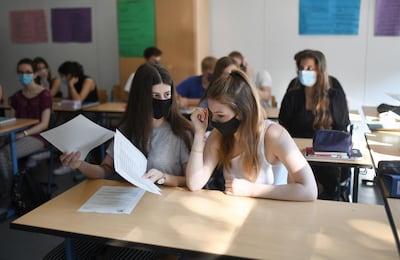Across the world, schools and universities are prime spots for the coronavirus to spread. But if nerves hold over for the next few weeks, the young could provide the route out of the crisis.
Few can doubt that a second wave of the pandemic has struck Europe. As the number of infections soar into the tens of thousands daily, different countries are setting their own priorities.
Germany's objective is to keep the infection rate suppressed to ensure the country’s test and trace system is not overwhelmed. One of Berlin's goals is an effective detection system that is able to establish how many people have been exposed to an outbreak. This is no mean feat in a country of more than 80 million, and such a detection system is worth defending.
For other countries, the priority is to ensure community transmission remains controlled enough to keep spare capacity in health care systems. If patients were to not receive intensive care treatment as a result of too high a demand for beds, it would result in a humanitarian catastrophe.
Despite different agendas to tackle the second wave, one area where Europeans agree is the need to protect the education system from the disruptive impact of an open-ended second shutdown.
The closure of schools earlier in spring is widely acknowledged to have been deeply damaging. Not only are pupils harmed by the lack of teaching but parents' work lives are upended, causing short-term economic damage.
Schools and universities should continue in-person teaching
Some authorities are extending the upcoming autumn half term as a result of the spike in infections. Two weeks, not one, is seen as minimally harmful to the economy, as many parents were anyway planning to take annual leave. There is no suggestion that closures could be extended beyond that — something that was a threat as recently as August.
Schoolchildren in Europe are mercifully not succumbing to Covid-19 in anything close to the numbers that have been seen among the elderly.
The massive outbreak among university students after the start of term has fed into interest in Sweden-style strategies of differentiating the lockdown across the age brackets.
Students contract the virus after moving from their family homes. While at university many live in distinct cohorts like halls of residence.
In university towns there are sharp drop offs between districts that have large student accommodation blocks and neighbouring districts where the students aren’t renting.
Students obviously go to shops and travel on public transport. But interaction with the wider public remains limited. They are not living in multi-generational settings. They are quarantined more easily. Indeed, the large-scale testing regimens put in place by the universities has uncovered cases that would never have been registered.
The statistical impact is already significant but the implications are not as clear cut. The path of the pandemic and how it will play out centres on whether or not the virus will slow as it saturates the younger age bracket.
A group of scientists have issued what has become known as the Barrington Declaration. This calls for a different set of building blocks towards the lockdown. It was signed by more than 6,000 medics and scientists.
One point is that the risk from coronavirus is 1,000 times higher for the old and infirm than the youngest. The risk of hospitalisation for people aged over 85 is more than 13 times that faced by an 18-year-old who contracts the disease, according to the US Centres for Disease Control. The risk of death is an astounding 630 times higher in older people.
An alternative course of action could be for the young and those who could be ascertained to be low risk to be allowed to continue to work in normal conditions. Schools and universities should continue in-person teaching.
The older and vulnerable could be targeted with support for isolation, including home shopping deliveries and being given guidance on measures like only meeting family outside, not indoors.
The Declaration has obvious flaws. It would mean that up to 16 million people would have to isolate during the crunch period when the virus spiked, as one British MP calculated last week.
Taking a base case of half the student age population and younger contracting the virus and just five per cent of the pension-age population testing positive, the MP’s calculations were that more than 1 mn would be hospitalised and there would be an additional 90,000 deaths.
While numbers like these can seem very definite, there is no comparable process for the cost of the lockdowns on mental and physical health, as a result of withdrawn health services and social isolation.
Economics does not have the same credibility as epidemiology. Yet, both fields rely on making judgements to construct extrapolation models. The result of this mismatch in expertise is that policymakers face unbearable pressure when infections spike.
Damien McElroy is the London bureau chief of The National
Turkish Ladies
Various artists, Sony Music Turkey
UAE currency: the story behind the money in your pockets
Tips for taking the metro
- set out well ahead of time
- make sure you have at least Dh15 on you Nol card, as there could be big queues for top-up machines
- enter the right cabin. The train may be too busy to move between carriages once you're on
- don't carry too much luggage and tuck it under a seat to make room for fellow passengers
Our legal consultant
Name: Dr Hassan Mohsen Elhais
Position: legal consultant with Al Rowaad Advocates and Legal Consultants.
UAE currency: the story behind the money in your pockets
THE%C2%A0SPECS
%3Cp%3E%3Cstrong%3EEngine%3A%20%3C%2Fstrong%3E2.4-litre%20four-cylinder%0D%3Cbr%3E%3Cstrong%3EPower%3A%3C%2Fstrong%3E%20210hp%0D%3Cbr%3E%3Cstrong%3ETorque%3A%3C%2Fstrong%3E%20320Nm%0D%3Cbr%3E%3Cstrong%3EPrice%3A%3C%2Fstrong%3E%20Starting%20from%20Dh89%2C900%0D%3Cbr%3E%3Cstrong%3EOn%20sale%3A%20%3C%2Fstrong%3ENow%0D%3Cbr%3E%3C%2Fp%3E%0A
How to invest in gold
Investors can tap into the gold price by purchasing physical jewellery, coins and even gold bars, but these need to be stored safely and possibly insured.
A cheaper and more straightforward way to benefit from gold price growth is to buy an exchange-traded fund (ETF).
Most advisers suggest sticking to “physical” ETFs. These hold actual gold bullion, bars and coins in a vault on investors’ behalf. Others do not hold gold but use derivatives to track the price instead, adding an extra layer of risk. The two biggest physical gold ETFs are SPDR Gold Trust and iShares Gold Trust.
Another way to invest in gold’s success is to buy gold mining stocks, but Mr Gravier says this brings added risks and can be more volatile. “They have a serious downside potential should the price consolidate.”
Mr Kyprianou says gold and gold miners are two different asset classes. “One is a commodity and the other is a company stock, which means they behave differently.”
Mining companies are a business, susceptible to other market forces, such as worker availability, health and safety, strikes, debt levels, and so on. “These have nothing to do with gold at all. It means that some companies will survive, others won’t.”
By contrast, when gold is mined, it just sits in a vault. “It doesn’t even rust, which means it retains its value,” Mr Kyprianou says.
You may already have exposure to gold miners in your portfolio, say, through an international ETF or actively managed mutual fund.
You could spread this risk with an actively managed fund that invests in a spread of gold miners, with the best known being BlackRock Gold & General. It is up an incredible 55 per cent over the past year, and 240 per cent over five years. As always, past performance is no guide to the future.
if you go
The flights Fly Dubai, Air Arabia, Emirates, Etihad, and Royal Jordanian all offer direct, three-and-a-half-hour flights from the UAE to the Jordanian capital Amman. Alternatively, from June Fly Dubai will offer a new direct service from Dubai to Aqaba in the south of the country. See the airlines’ respective sites for varying prices or search on reliable price-comparison site Skyscanner.
The trip
Jamie Lafferty was a guest of the Jordan Tourist Board. For more information on adventure tourism in Jordan see Visit Jordan. A number of new and established tour companies offer the chance to go caving, rock-climbing, canyoning, and mountaineering in Jordan. Prices vary depending on how many activities you want to do and how many days you plan to stay in the country. Among the leaders are Terhaal, who offer a two-day canyoning trip from Dh845 per person. If you really want to push your limits, contact the Stronger Team. For a more trek-focused trip, KE Adventure offers an eight-day trip from Dh5,300 per person.
VERSTAPPEN'S FIRSTS
Youngest F1 driver (17 years 3 days Japan 2014)
Youngest driver to start an F1 race (17 years 166 days – Australia 2015)
Youngest F1 driver to score points (17 years 180 days - Malaysia 2015)
Youngest driver to lead an F1 race (18 years 228 days – Spain 2016)
Youngest driver to set an F1 fastest lap (19 years 44 days – Brazil 2016)
Youngest on F1 podium finish (18 years 228 days – Spain 2016)
Youngest F1 winner (18 years 228 days – Spain 2016)
Youngest multiple F1 race winner (Mexico 2017/18)
Youngest F1 driver to win the same race (Mexico 2017/18)
The Sand Castle
Director: Matty Brown
Stars: Nadine Labaki, Ziad Bakri, Zain Al Rafeea, Riman Al Rafeea
Rating: 2.5/5
Company%20profile
%3Cp%3EName%3A%20Tabby%3Cbr%3EFounded%3A%20August%202019%3B%20platform%20went%20live%20in%20February%202020%3Cbr%3EFounder%2FCEO%3A%20Hosam%20Arab%2C%20co-founder%3A%20Daniil%20Barkalov%3Cbr%3EBased%3A%20Dubai%2C%20UAE%3Cbr%3ESector%3A%20Payments%3Cbr%3ESize%3A%2040-50%20employees%3Cbr%3EStage%3A%20Series%20A%3Cbr%3EInvestors%3A%20Arbor%20Ventures%2C%20Mubadala%20Capital%2C%20Wamda%20Capital%2C%20STV%2C%20Raed%20Ventures%2C%20Global%20Founders%20Capital%2C%20JIMCO%2C%20Global%20Ventures%2C%20Venture%20Souq%2C%20Outliers%20VC%2C%20MSA%20Capital%2C%20HOF%20and%20AB%20Accelerator.%3Cbr%3E%3C%2Fp%3E%0A
If you go
The flights Etihad (www.etihad.com) and Spice Jet (www.spicejet.com) fly direct from Abu Dhabi and Dubai to Pune respectively from Dh1,000 return including taxes. Pune airport is 90 minutes away by road.
The hotels A stay at Atmantan Wellness Resort (www.atmantan.com) costs from Rs24,000 (Dh1,235) per night, including taxes, consultations, meals and a treatment package.
Global Fungi Facts
• Scientists estimate there could be as many as 3 million fungal species globally
• Only about 160,000 have been officially described leaving around 90% undiscovered
• Fungi account for roughly 90% of Earth's unknown biodiversity
• Forest fungi help tackle climate change, absorbing up to 36% of global fossil fuel emissions annually and storing around 5 billion tonnes of carbon in the planet's topsoil
TWISTERS
Director: Lee Isaac Chung
Starring: Glen Powell, Daisy Edgar-Jones, Anthony Ramos
Rating: 2.5/5
Results
United States beat UAE by three wickets
United States beat Scotland by 35 runs
UAE v Scotland – no result
United States beat UAE by 98 runs
Scotland beat United States by four wickets
Fixtures
Sunday, 10am, ICC Academy, Dubai - UAE v Scotland
Admission is free
EA Sports FC 24
What can victims do?
Always use only regulated platforms
Stop all transactions and communication on suspicion
Save all evidence (screenshots, chat logs, transaction IDs)
Report to local authorities
Warn others to prevent further harm
Courtesy: Crystal Intelligence
How%20I%20connect%20with%20my%20kids%20when%20working%20or%20travelling
%3Cp%3E%0D%3Cstrong%3ELittle%20notes%3A%20%3C%2Fstrong%3EMy%20girls%20often%20find%20a%20letter%20from%20me%2C%20with%20a%20joke%2C%20task%20or%20some%20instructions%20for%20the%20afternoon%2C%20and%20saying%20what%20I%E2%80%99m%20excited%20for%20when%20I%20get%20home.%0D%3Cbr%3E%3Cstrong%3EPhone%20call%20check-in%3A%20%3C%2Fstrong%3EMy%20kids%20know%20that%20at%203.30pm%20I%E2%80%99ll%20be%20free%20for%20a%20quick%20chat.%0D%3Cbr%3E%3Cstrong%3EHighs%20and%20lows%3A%20%3C%2Fstrong%3EInstead%20of%20a%20%E2%80%9Chow%20was%20your%20day%3F%E2%80%9D%2C%20at%20dinner%20or%20at%20bathtime%20we%20share%20three%20highlights%3B%20one%20thing%20that%20didn%E2%80%99t%20go%20so%20well%3B%20and%20something%20we%E2%80%99re%20looking%20forward%20to.%0D%3Cbr%3E%3Cstrong%3EI%20start%2C%20you%20next%3A%20%3C%2Fstrong%3EIn%20the%20morning%2C%20I%20often%20start%20a%20little%20Lego%20project%20or%20drawing%2C%20and%20ask%20them%20to%20work%20on%20it%20while%20I%E2%80%99m%20gone%2C%20then%20we%E2%80%99ll%20finish%20it%20together.%0D%3Cbr%3E%3Cstrong%3EBedtime%20connection%3A%20%3C%2Fstrong%3EWake%20up%20and%20sleep%20time%20are%20important%20moments.%20A%20snuggle%2C%20some%20proud%20words%2C%20listening%2C%20a%20story.%20I%20can%E2%80%99t%20be%20there%20every%20night%2C%20but%20I%20can%20start%20the%20day%20with%20them.%0D%3Cbr%3E%3Cstrong%3EUndivided%20attention%3A%20%3C%2Fstrong%3EPutting%20the%20phone%20away%20when%20I%20get%20home%20often%20means%20sitting%20in%20the%20car%20to%20send%20a%20last%20email%2C%20but%20leaving%20it%20out%20of%20sight%20between%20home%20time%20and%20bedtime%20means%20you%20can%20connect%20properly.%0D%3Cbr%3E%3Cstrong%3EDemystify%2C%20don%E2%80%99t%20demonise%20your%20job%3A%20%3C%2Fstrong%3EHelp%20them%20understand%20what%20you%20do%2C%20where%20and%20why.%20Show%20them%20your%20workplace%20if%20you%20can%2C%20then%20it%E2%80%99s%20not%20so%20abstract%20when%20you%E2%80%99re%20away%20-%20they%E2%80%99ll%20picture%20you%20there.%20Invite%20them%20into%20your%20%E2%80%9Cother%E2%80%9D%20world%20so%20they%20know%20more%20about%20the%20different%20roles%20you%20have.%3C%2Fp%3E%0A
Name: Brendalle Belaza
From: Crossing Rubber, Philippines
Arrived in the UAE: 2007
Favourite place in Abu Dhabi: NYUAD campus
Favourite photography style: Street photography
Favourite book: Harry Potter
Women’s World T20, Asia Qualifier
UAE results
Beat China by 16 runs
Lost to Thailand by 10 wickets
Beat Nepal by five runs
Beat Hong Kong by eight wickets
Beat Malaysia by 34 runs
Standings (P, W, l, NR, points)
1. Thailand 5 4 0 1 9
2. UAE 5 4 1 0 8
3. Nepal 5 2 1 2 6
4. Hong Kong 5 2 2 1 5
5. Malaysia 5 1 4 0 2
6. China 5 0 5 0 0
Final
Thailand v UAE, Monday, 7am
Paatal Lok season two
Directors: Avinash Arun, Prosit Roy
Stars: Jaideep Ahlawat, Ishwak Singh, Lc Sekhose, Merenla Imsong
Rating: 4.5/5
The specs: 2018 Audi RS5
Price, base: Dh359,200
Engine: 2.9L twin-turbo V6
Transmission: Eight-speed automatic
Power: 450hp at 5,700rpm
Torque: 600Nm at 1,900rpm
Fuel economy, combined: 8.7L / 100km
Countries recognising Palestine
France, UK, Canada, Australia, Portugal, Belgium, Malta, Luxembourg, San Marino and Andorra
UPI facts
More than 2.2 million Indian tourists arrived in UAE in 2023
More than 3.5 million Indians reside in UAE
Indian tourists can make purchases in UAE using rupee accounts in India through QR-code-based UPI real-time payment systems
Indian residents in UAE can use their non-resident NRO and NRE accounts held in Indian banks linked to a UAE mobile number for UPI transactions
Classification of skills
A worker is categorised as skilled by the MOHRE based on nine levels given in the International Standard Classification of Occupations (ISCO) issued by the International Labour Organisation.
A skilled worker would be someone at a professional level (levels 1 – 5) which includes managers, professionals, technicians and associate professionals, clerical support workers, and service and sales workers.
The worker must also have an attested educational certificate higher than secondary or an equivalent certification, and earn a monthly salary of at least Dh4,000.
Drivers’ championship standings after Singapore:
1. Lewis Hamilton, Mercedes - 263
2. Sebastian Vettel, Ferrari - 235
3. Valtteri Bottas, Mercedes - 212
4. Daniel Ricciardo, Red Bull - 162
5. Kimi Raikkonen, Ferrari - 138
6. Sergio Perez, Force India - 68
Points tally
1. Australia 52; 2. New Zealand 44; 3. South Africa 36; 4. Sri Lanka 35; 5. UAE 27; 6. India 27; 7. England 26; 8. Singapore 8; 9. Malaysia 3
COMPANY PROFILE
Company name: Blah
Started: 2018
Founder: Aliyah Al Abbar and Hend Al Marri
Based: Dubai
Industry: Technology and talent management
Initial investment: Dh20,000
Investors: Self-funded
Total customers: 40
Specs
Engine: Dual-motor all-wheel-drive electric
Range: Up to 610km
Power: 905hp
Torque: 985Nm
Price: From Dh439,000
Available: Now
More from Aya Iskandarani
UAE currency: the story behind the money in your pockets
Profile box
Company name: baraka
Started: July 2020
Founders: Feras Jalbout and Kunal Taneja
Based: Dubai and Bahrain
Sector: FinTech
Initial investment: $150,000
Current staff: 12
Stage: Pre-seed capital raising of $1 million
Investors: Class 5 Global, FJ Labs, IMO Ventures, The Community Fund, VentureSouq, Fox Ventures, Dr Abdulla Elyas (private investment)
AUSTRALIA%20SQUAD
%3Cp%3EPat%20Cummins%20(capt)%2C%20Scott%20Boland%2C%20Alex%20Carey%2C%20Cameron%20Green%2C%20Marcus%20Harris%2C%20Josh%20Hazlewood%2C%20Travis%20Head%2C%20Josh%20Inglis%2C%20Usman%20Khawaja%2C%20Marnus%20Labuschagne%2C%20Nathan%20Lyon%2C%20Mitchell%20Marsh%2C%20Todd%20Murphy%2C%20Matthew%20Renshaw%2C%20Steve%20Smith%2C%20Mitchell%20Starc%2C%20David%20Warner%3C%2Fp%3E%0A




